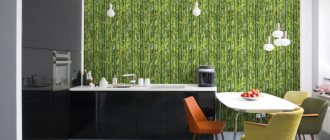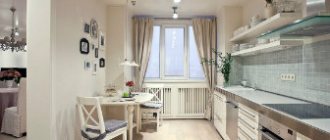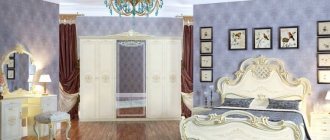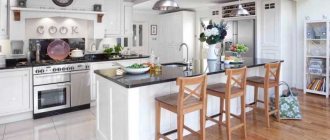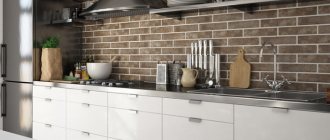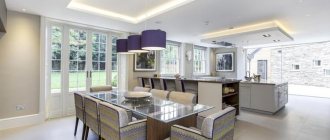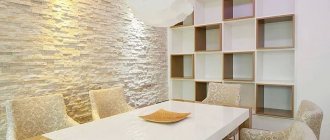When arranging their home or making cosmetic repairs in the kitchen, many people wonder what they can use to make an “apron” or “screen”. This is what we call the covering for the wall near which the gas stove is located.
First of all, it should be said how the concept of “apron” differs from the concept of “screen” - solely in size. The “apron” is the part of the wall located directly behind the gas stove; the “screen” is usually the entire wall next to which the stove is located, including the space between the wall-mounted and floor-mounted kitchen cabinets. But they have the same mission - protection from burning and grease. Therefore, we offer you the best ideas and practical tips on how to close the wall behind a gas stove.
PVC panels
Extruded polyvinyl chloride is a budget alternative to an expensive tiled apron.
It is plastic and does not impose any special installation requirements: you can fasten the panels yourself without spending a lot of time. Also, the products do not impose any special requirements on the wall surface. Unfortunately, most panels have a short service life, and they are not resistant to chemicals and high temperatures, and can also fade.
To avoid their deformation, you should choose a material marked with heat and moisture resistance.
PVC aprons come in two formats: in the form of a solid sheet or slats (lining). The panels are sold with a ready-made design - in the form of tiles, mosaics, bricks, with drawings and imitation of various textures. Based on the type of coating, they are divided into matte and glossy (the second option is more resistant to washing). Installed with liquid nails or screws.
Comparison of materials
What is the best way to make an apron? Does the owner of a house or apartment decide based on financial capabilities and the tasks that need to be solved? A table that summarizes all the strengths and weaknesses of the materials reviewed will help you figure this out, as well as short recommendations for those who do not like to leaf through the material for a long time in search of an answer.
| Material | Practicality | Heat resistance | Moisture resistance | Easy to install | Life time |
| Ceramics | + | + | + | — | + |
| Mosaic | — | + | + | — | + |
| MDF | — | — | — | + | — |
| Glass | + | + | + | — | + |
| Plastic | + | — | + | + | + |
| Mirror | — | + | + | — | + |
| Stone | + | + | + | — | + |
| Metal | — | + | + | — | + |
| Laminate | + | — | — | + | — |
The best option in terms of price and quality ratio
The most inexpensive solution for wall finishing would be MDF or plastic panels, which are easy to install with your own hands. The most expensive option would be to use natural stone or expensive tiles with panels.
Glass is inexpensive, but by printing photos on the wall you can create the most fashionable and unique space design.
It is most beneficial to combine different materials to protect individual areas in the room. For example, you can use cheap plastic panels for the eating area, and use standard tiles or decorative stone for the cooking area.
Laminate
The use of laminate instead of an apron is justified by the high performance properties of the coating. It is easy to install, easy to care for, and even after several years it does not lose its attractive appearance.
An apron made of laminate will cost less than one made of ceramic tiles, and it will also add coziness to the kitchen - wood and its imitation never go out of fashion and fit well into most styles.
To ensure that the laminated apron performs its functions longer, choose moisture-resistant panels of class 31 and 32 and treat the seams with special glue. The only drawback of the material is its poor resistance to high temperatures.
Replacement options at minimal cost
Almost everyone faces renovations in their home. Most often, windows and ceilings are painted, and wallpaper on the walls is changed. Less often, floors are re-laid and ceramic tiles are replaced. Until now, in many apartments you can find tiles from Soviet times, which are not particularly aesthetically pleasing. Some owners do not dare replace the tiles, thinking that there is no alternative, and they are unable to save up for new high-quality ceramics.
But there is a way out, and it’s simple and relatively inexpensive. For budget wall decoration in the kitchen you can use:
- vinyl siding;
- plastic panels;
- Wallpaper – moisture-resistant, fiberglass, liquid.
Siding and panels are available in different colors, plain and patterned. The slats can be installed vertically, diagonally or horizontally, as well as in various combinations. If you use your imagination, the design of the kitchen will turn out to be original and unique. But this replacement option has one significant drawback.
The technology for installing vinyl siding and plastic panels requires the construction of a frame for attaching the lamellas. Due to this, the dimensions of the room are reduced on each side from two to five centimeters, which is unacceptable for small kitchens.
If a thick layer of mortar remains on the walls after removing the tiles, it can be removed and wooden blocks of small cross-section used as a frame. This will preserve the dimensions of the kitchen after installing the panels, but labor costs will increase significantly.
You can replace tiles with waterproof or fiberglass wallpaper only after carefully leveling the surface freed from tiles. Her:
- plastering;
- prime;
- putty;
- treated with antiseptics.
Only moisture-resistant mixtures can be used as glue. Colored latex paint is additionally applied to fiberglass wallpaper.
You can replace tiles with liquid wallpaper without a base-leveling layer. In the kitchen, such walls will look non-standard. Liquid wallpaper is applied to the surface using a plastic spatula, resulting in a smooth plane with a unique pattern. For additional protection, finished walls can be treated with a moisture-resistant compound that forms a durable film on the surface.
Glass
This is an absolutely environmentally friendly material, widely used in interiors. To protect the kitchen wall, ordinary glass will not work: only tempered glass will withstand the heat from the stove. The glass apron is not afraid of water, is easy to clean from grease, and does not absorb odors.
Transparent material gives the kitchen lightness, fitting perfectly into minimalism, loft and modern style. Can be colored or transparent. Suitable for small kitchens, as it increases the space thanks to its unobtrusive reflective effect. Indispensable if you need to protect an unusual or aggressive coating.
Disadvantages: inability to drill additional holes.
Creative ideas
A simple and affordable way to make the design of a room interesting is to use printed tiles. It will give the interior individuality and emphasize the style direction. The pattern should be used in moderation, otherwise it will deprive the design of lightness or make it completely tasteless and motley.
In the color of wood Source www.shirokoi.org
Three-dimensional tiles look elegant and weightless. There is a wide range of textures on sale. To decorate the work area, you need to choose models that are easy to clean, since the apron is constantly exposed to moisture, steam and grease. It is advisable to lay out the lower part of the zone with glazed tiles, and the upper part in three-dimensional tiles.
“Chopped” tiles Source www.panoramica3d.ru
Unusual tiles in bright colors will add bold accents to your kitchen interior design and attract attention to detail. Spectacular ornaments, rich colors, bold color combinations will give the room a unique flavor.
Geometric pattern Source www.apartmenttherapy.com
Mosaic is an elegant way to decorate a kitchen space. Be sure to properly seal the seams and choose the right shade of finishing material. Mosaic tiles can also be used to decorate other kitchen work surfaces (countertops, shelves, window sills).
Ceramics with the effect of laying pebbles Source znatprovse.ru
Matte ceramics will look great in the interior of large kitchens. The main thing is that it is not porous (it is difficult to clean such tiles). A good idea for a small room would be an apron with mirror inserts. Gloss and glass inserts visually expand the boundaries of the room, making it more spacious and brighter.
Mosaic tiles on the apron Source dizainall.com
Ceramics with a honeycomb imitation will help hide boxes and protruding corners of furniture. It does not affect the visual perception of the room, but it looks very interesting and unusual due to the abundance of broken lines. Honeycombs are available in different sizes (from small square tiles of 6 by 6 cm to large fragments of 48 by 48 cm).
Honeycomb tiles for the kitchen Source www.pinterest.com
Wallpaper
The main advantages of a wallpaper apron are ease of pasting and a huge selection of colors. It is better to use moisture-resistant fabrics as materials, which will last longer than paper ones. This is an ideal option for those who want to decorate their kitchen, bringing its design closer to the living room, and for those who do not cook much.
Another practical solution is commercial vinyl wallpaper. Unfortunately, even the most resistant fabrics will not withstand drops of fat that fall on the surface, as well as constant temperature changes. It is not easy to care for such an apron, because you cannot rub it with a hard and wet sponge.
To protect the wallpaper from the effects of cooking, it should be varnished or covered with a removable glass panel, and, if desired, replaced.
Criteria for choosing material for a kitchen apron
The kitchen apron is designed to protect the base from heat, grease drops and coloring splashes from plant foods, which means that when selecting the material, the following characteristics should be taken into account.
Dimensions
When determining the size of the apron, you must adhere to the following rules:
- the extreme points of the apron in height should overlap the lower and upper cabinets by 20-30 mm;
- the total height of the apron is from 450 to 600 mm (depending on the height of the people who will cook in the kitchen);
- The width of the apron must necessarily cover the working areas near the stove and sink. It looks beautiful when the protection covers the entire line of the headset;
- when installing an apron over a gas stove, you need to take into account the minimum distance from the surface of the stove to the hood (750-800 mm);
- if there are no upper cabinets, the wall protection should be brought up to the ceiling.
Color
The color scheme of the apron should be in harmony with the overall decoration of the room and the color of the set. Designers' advice boils down to the following recommendations:
- universal colors for the kitchen space are: white, beige and cream;
- It is undesirable to use shades of blue and purple;
- bright red and orange inserts will help awaken your appetite;
- if a white set is installed in the kitchen, it is better to make the apron from dark or colored materials;
- It is recommended to dilute the gray design with bright colored mosaics;
- dark-colored wooden furniture is diluted with light tones;
- in kitchen sets made of MDF to imitate natural wood, aprons that also imitate wood, but a tone or two lighter, will look good;
- For spaces that have little natural light, you need to choose light, light colors.
Style
The material and texture must match the overall stylistic design of the room and furniture. For certain styles and finishing areas, the following options are recommended for what to make an apron from in the kitchen:
- ceramic tiles from Italy are an ideal solution for loft-style spaces;
- mosaic tiles or glass will enrich the eclectic look;
- for kitsch it is recommended to use mirror tiles;
- Mediterranean flavor will allow you to create panels on ceramics;
- stone (natural or artificial) will fit organically into the solemn Victorian style;
- metal and glass will find their place in high-tech.
Mosaic.
Window
Installing a window in place of a kitchen apron in a private home will give the kitchen a unique style and add more light. Window installation is associated with some difficulties, and therefore requires extreme precision and caution from the master.
It is important that the window opening is at the same level as the tabletop, and also does not rise too high, because cabinets are supposed to be hung above it. Users who have a window instead of an apron appreciate this option for its originality, convenience, and easy care. Not suitable for those who like privacy.
Decorative plaster
The way to decorate the apron area can be refined or, on the contrary, rough. Venetian plaster looks harmonious in a classic style, while a concrete-like finish looks good in a loft, and the rougher the material for the apron, the more expensive the furniture and fittings should be. Decorative plaster has high strength and wear resistance. The main thing is to choose a composition that is not afraid of moisture, and coat the finished apron with varnish.
The only difficulty is that the overly textured surface is difficult to clean.
Photos of kitchen interiors without ceramic tiles
In the apron area and on the floor, not only tiles are used, but also other finishing options. You can choose the material to suit almost any tastes and capabilities. The main thing is to imagine the desired result.
Dye
This inexpensive material gives unlimited possibilities when choosing the color of the apron, because the composition can be tinted in any color. Buy paint that can be washed with household chemicals and wiped down frequently - then the coating will last a long time. Leave some of the paint so that the splashback can be restored if necessary.
The main requirement for a wall intended for painting is a perfectly flat surface.
Decorative rock
Suitable for aesthetes and connoisseurs of brutal textures. Natural stone is the most durable, but has a high cost. A more affordable option is artificial agglomerate, as well as colored concrete that imitates shell rock.
In addition, the apron can be laid out from budget gypsum tiles “like stone” or “brick”, but their textured and porous surface must be protected with varnish or glass. You can lay such an apron yourself.
Slate
Painting a kitchen apron with black chalk paint is not only a practical, but also an original option. The wall will be easy to clean, since chalkboard paint is resistant to long-term external influences. You can draw on the apron, leave notes, write menus and recipes.
Before painting, the surface must be leveled. The composition should be applied in three layers to achieve an even coating. One liter is enough to cover a two-meter apron in two layers.
There are many ways to design a kitchen apron - they all have their advantages and disadvantages. Before choosing a material, you should consider your financial capabilities, as well as cooking methods and the availability of a dishwasher. People who rarely use the sink and stove can not worry about the performance properties of the apron and show their imagination without limiting themselves.
What can you do instead of an apron?
If it is impossible to equip the apron using traditional methods, it is recommended to protect the surface in the following ways:
- Paint the surface with waterproof glossy paint. The wall must first be leveled and treated with a suitable primer.
- Paste wallpaper based on materials that are resistant to moisture (non-woven fabric, vinyl). It should be remembered that wallpaper can easily ignite if it is located close to a gas stove.
- Plaster. For surface finishing, you should choose mineral or synthetic materials with the addition of pigments that match the color scheme of the kitchen set.
- Use special durable paint for slate boards.
